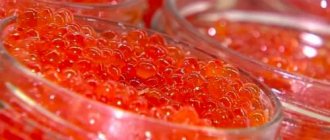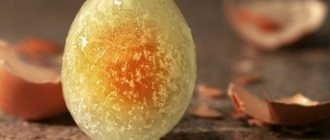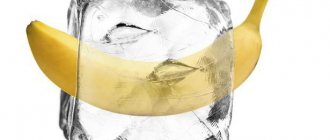As the New Year holidays approach, many housewives are wondering how to preserve red caviar so that it does not spoil for as long as possible. This question is especially relevant in cases where you need to freeze a large amount of red caviar for the holidays.
In order for the product to be as tasty and healthy after defrosting, all conditions must be met, and the red caviar itself must be of good quality. Therefore, first, let's try to decide how to buy a high-quality and good product.
Before purchasing, you should evaluate caviar according to such parameters as:
- Appearance – the naturalness of the product is evidenced by small black dots on the eggs – these are future fry.
- The product is tested - there is no unpleasant odor, the caviar does not taste bitter and bursts in the mouth with light pressure.
- The indicated composition on the container - read the label carefully, a quality product contains nothing except caviar, salt and vegetable oil. The presence of other components and synthetic additives indicates low quality and unnatural caviar.
- Shaking the container - if there are splashes in the jar, you should refuse the purchase.
- Container - of course, it is better to choose caviar that is packaged in a tin jar, since the plastic is easy to open, it is not airtight and the caviar can easily spoil even before purchase.
- Region of production - be sure to read where the product was made, because the closer it is to the place where the fish were caught, the fresher the caviar arrives at the factory, where the manufacturer tries to immediately preserve it. In addition, during long-term transportation, storage rules can easily be violated, and caviar can easily be poisoned.
Nowadays there is quite a large assortment of red caviar both in markets (where it is extremely undesirable to buy it, especially before the New Year holidays), and in stores or supermarkets. It is recommended to purchase the product at trusted large retail outlets, since the smaller the store, the less responsibility the sellers have for correct storage conditions. Here we wrote about which red caviar is best to buy.
Therefore, in order not to ruin the mood of yourself and your guests on New Year’s Eve by the lack of a quality delicacy, and to avoid accidentally harming your health, you need to make purchases in trusted places and from trusted sellers.
Secrets and rules for freezing fresh or salted red caviar
Let's try to imagine that you were unexpectedly lucky and were able to purchase a large amount of a tasty and healthy delicacy at an affordable price. A difficult question immediately arises - how now to preserve the product so that it does not deteriorate and lose its freshness? Is it possible to freeze red caviar - this is a question that worries many?
Of course, it’s enough to simply freeze it; this is the easiest and most convenient way for home use. Although there will probably be supporters here who say that caviar should not be frozen, since this supposedly loses its beneficial properties. But on the other hand, is it better for caviar to spoil and disappear while being stored in the refrigerator rather than in the freezer?
In addition, there is a high probability of poisoning. After all, if you follow all the rules of freezing and subsequent defrosting, then the caviar will remain tasty and healthy even after defrosting, and it will be almost impossible to distinguish it from a fresh product.
But, unfortunately, not everyone knows the correct conditions for freezing caviar and subsequent thawing without loss of quality. And then after defrosting, instead of appetizing and crumbly caviar, you end up with an indistinct sticky mass that you just have to throw away. Is it possible to freeze salted red caviar for storage in the freezer? Yes, in exactly the same way as the rest.
For freezing red caviar, a small plastic container, always with a lid, is most ideal.
Good to know! Containers can be purchased in hardware departments or stores, and even thin ones, in which ready-made salads are usually sold in supermarkets, are suitable.
Many people wonder how to properly freeze salted and loose red caviar? In order to properly freeze caviar for storage in the freezer, you need to prepare a container; it is not enough to just buy it, immediately transfer the product into it and stuff the containers into the freezer. To begin with, it is recommended to thoroughly wash and dry them, and then lubricate the walls of the jars with vegetable oil, or better yet, odorless olive oil.
Now you can spread the caviar in them quite tightly. The product in containers should be covered with parchment paper greased with oil or pour a little oil on top. Close the lid and wrap with cling film so that the product does not absorb foreign odors during storage, and freeze the red caviar in the freezer.
Before placing the containers in the freezer, you should cool them in the refrigerator for at least 3-4 hours, and if this is not done, then, most likely, the appearance of the delicacy will undergo significant changes after defrosting. This product can be stored for up to 6-7 months if the refrigerator has not been defrosted.
When is it advisable to freeze?
Probably, for the vast majority this question does not arise at all. After all, what’s the point of freezing a small jar, as they say, “for one tooth.” But if you are blessed with a couple of kilograms of this “red gold”, then, of course, you want to stretch out the pleasure for a long time.
Besides the fact that it is very tasty, it also has many beneficial properties.
An important condition is the quality of the product. It is recommended to freeze only high quality caviar. Moreover, during the freezing process, certain conditions must be observed so that the delicacy does not turn into a shapeless sticky mass of “indistinct” color.
When purchasing loose caviar, do not forget about its shelf life: for packaged caviar it is no more than 4 months.
Finally, there is an answer to the question of how long red caviar can be stored frozen. The best option is up to six months, provided that the temperature is constantly low. Well, if this delicacy “stayed” in your refrigerator for more than 7 months, you shouldn’t eat it. Believe me, spoiled health will cost you more than the cost of disposed caviar.
Pink salmon caviar is a very valuable, tasty and nutritious product.
By the way, before freezing, it would be nice to find out how the caviar was obtained and whether it was frozen. For example, on fishing vessels, caviar is often blast-frozen as soon as it is removed from the fish. After this, they are immersed in a saline solution and placed in an airtight container. This is the best method of extraction and storage. In this form, caviar does not lose its beneficial properties for up to two years.
If you want to extend the storage period of caviar from an open iron can, transfer it to a glass container, after rinsing it with salt water and drying it.
How to properly defrost red caviar?
To begin with, the packaging should be placed on the bottom shelf of the refrigerator, and only after 10-12 hours should it be moved to the top shelf for 3-4 hours. After this, only 1-1.5 hours at room temperature will be enough for the caviar to completely melt and at the same time retain its consistency. Now you know how to properly freeze red caviar in the freezer, and then defrost it.
Important! You should not immediately expose the package of caviar to heat, placing it, for example, on the work surface of the kitchen table to thaw.
How to properly store a jar of opened red caviar in the refrigerator?
To preserve caviar, and indeed any products, refrigeration or freezing is used. According to GOST, caviar is stored from +3 to + 5 degrees, in the coolest place in the refrigerator. The shelf life of unopened packaging is 1 year.
Those owners of the delicacy who have a freshness zone in the refrigerator will also be lucky - there is a lower temperature, which has a beneficial effect on the safety of the product.
From a metal jar, the delicacy must definitely be transferred to a clean small plastic container or glass jar so that the eggs do not oxidize under the influence of the tin. Moreover, any container must be rinsed with boiling water, and then thoroughly dried and greased with olive oil on the bottom and walls.
Opened caviar can be stored in the refrigerator in a tightly closed container under a film of vegetable oil, but not in tin cans. And you should remember that the faster the caviar is eaten, the greater the benefits for the body. Therefore, you should not delay use.
Important! If the delicacy smells unpleasant, the caviar has become too watery and cloudy, there is no need to risk your health and the well-being of your loved ones, in this case you should throw away the probably already spoiled product.
Pros and cons for health
Despite all its value and usefulness, red caviar has its own benefits and harms.
What are the benefits for the body?
Due to its rich vitamin composition, nutritionists consider this product unique. Recommended dose: 3-5 teaspoons per day:
- Strengthens the immune system, prevents atherosclerosis.
- Rich in vitamins and minerals.
- Fatty acids contained in caviar have a beneficial effect on the functioning of the cardiovascular system and slow down the aging process.
- Has a positive effect on visual acuity.
- Used for cosmetic purposes to maintain youth and beauty, caviar stimulates the production of collagen.
Harmful properties
In order not to harm our body, we need to buy a high-quality product:
- The main danger lies in counterfeit products. A low-quality manufacturer adds the food additive E239 (urotropine) to extend the shelf life. This is a very toxic preservative that, if ingested, causes damage to the central nervous system.
- Caviar is a very high-calorie product, so it is a heavy food for the stomach.
- The salt included in the composition retains fluid in the body, which has a bad effect on metabolism. Therefore, people suffering from edema are strictly prohibited from consuming salted caviar.
But still, the red delicacy has more beneficial properties, so be careful about your choice and storage conditions. Consume this delicacy in moderation and enjoy it!
Features of storing red caviar in a glass jar
To store caviar in a glass container with a tightly sealed lid (with a silicone gasket), or a regular tin lid, first of all, you need to wash the container very thoroughly, first with detergent and then with baking soda. After which the container must be rinsed with boiling water and allowed to dry naturally.
To better preserve the product, you can make brine (a strong saline solution) and scald the container again. After which, the walls are lubricated with odorless vegetable oil, the caviar is laid out so that when transferring, the eggs do not wrinkle or burst. If desired, you can also add oil on top depending on the amount of product, but just a little to form a thin film.
Regulatory and technical base
Let's consider what requirements for salmon caviar are set by national standards.
Technical standards
It should be noted right away that granular caviar is divided into categories into first and second grade. In addition to the mandatory requirements: clean and intact eggs and uniform color, there are permissible exceptions.
First grade:
- damaged eggs - a small amount;
- elastic, moistened or dry surface, eggs are easily separated;
- no foreign odors;
- a slight bitter taste is possible.
Second grade:
- It is permissible to mix caviar of different types of fish, which gives a heterogeneous consistency;
- possible broken eggs and pieces of film;
- The viscosity of the composition is allowed, but the pronounced granular structure must be preserved.
- Possible bitter or pungent aftertaste.
Plastic container for storing delicacies
As for plastic, for storage it is best to choose disposable tableware rather than home containers, which get scratched over time and absorb odors well.
These jars with fairly tight-fitting lids, which are usually used to put ready-made food in supermarkets, can be purchased at large hardware stores, and they are incredibly convenient for such purposes. After use, you just have to throw them away, and there is no need to wash the dishes to remove greasy oil and fishy smell.
Advice! Before use, they also need to be thoroughly washed and dried, but scalding them will not work, since the thin plastic will immediately deform. Therefore, the shelf life in such a container is slightly reduced.
Canning red caviar for storage
Red caviar is considered a delicacy, so housewives try to preserve a large batch purchased by any means in order to pamper their guests at the festive table. The product can not only be frozen, but also canned, and this is quite easy to do at home.
For 1 kg of product you will need:
- red caviar - 1 kg;
- coarse table salt - 85 gr.;
- Potassium nitrate – 1 gr.
How to prepare it correctly?
In order to pickle caviar, you need to rinse it a little in boiled water and let the liquid drain, or use fresh caviar.
Interesting! Potassium nitrate is used only to preserve the natural red color of the delicacy.
Mix the prepared caviar with salt, place in sterilized jars washed with soda, seal with lids and put in a cool place. The storage temperature should not be higher than 0 °C.
The product will be completely ready for consumption in a couple of months, and it is recommended to prepare the delicacy in small portions.
What regulations govern the conditions of production, storage and sale?
Salmon or red caviar is extracted and preserved according to the same rules. The conditions under which the product is produced, stored and sold are specified in GOST 31794-2012 “Granular salmon caviar”. This regulatory document covers the field of delicacy production in general. It sets out rules for product that is stored in barrels and sold by weight.
Most consumers purchase caviar in canned form. Small glass or tin jars can be found on the shelves of almost all grocery stores. When preserving salmon products, the actions of the manufacturer are regulated by GOST 18173-2004.
Important! Red caviar is not always packaged from a fresh, chilled product. According to legal regulations, it can be frozen for longer storage.
The freezing and storage process is described in GOST 31793-2012.
All regulatory legal acts must stipulate the requirements for technical production conditions, the rules:
- transportation;
- conservation;
- packaging;
- markings;
- storage, etc.
Useful tips for housewives
Be sure to remember that red caviar should never be re-frozen. To increase the amount of product for a feast, you can cheat a little and dilute the real product with an artificial one. You just need to do this carefully and add a small amount so that the taste of the delicacy does not change much.
Before purchasing, you should carefully study the information about where the product was packaged - and purchase the jar that contains information about Far Eastern cities. But, unfortunately, little real caviar is produced there, and the rest of the caviar comes to us in bulk from America and is packaged in tin cans at fish factories.
How do you like the article?
Choosing a quality product
A lot of red caviar is sold both in chain stores and in markets and specialized shops. There are so many manufacturers and names. My eyes widen. But they are the ones who will help us choose high-quality caviar.
Here's what you should pay attention to when purchasing:
- the eggs should be one to one in size and density; if they are wrinkled and heterogeneous, then most likely they have been defrosted;
- the abundant presence of mucus and excess liquid is unacceptable; caviar should be crumbly and not glued together;
- the jar must indicate all the necessary information about the manufacturer, place of manufacture, date of packaging;
- what technology was used for salting - GOST or TU: GOST has more stringent quality requirements, it does not allow the product to freeze and clearly regulates the amount of water and salt, in contrast to the technical conditions;
- the composition of the product ideally includes table salt and caviar (adding a small amount of oil and sorbic acid (E200) will not be a violation of technology);
- Is there a feeling of excess water if you shake an opaque jar?











